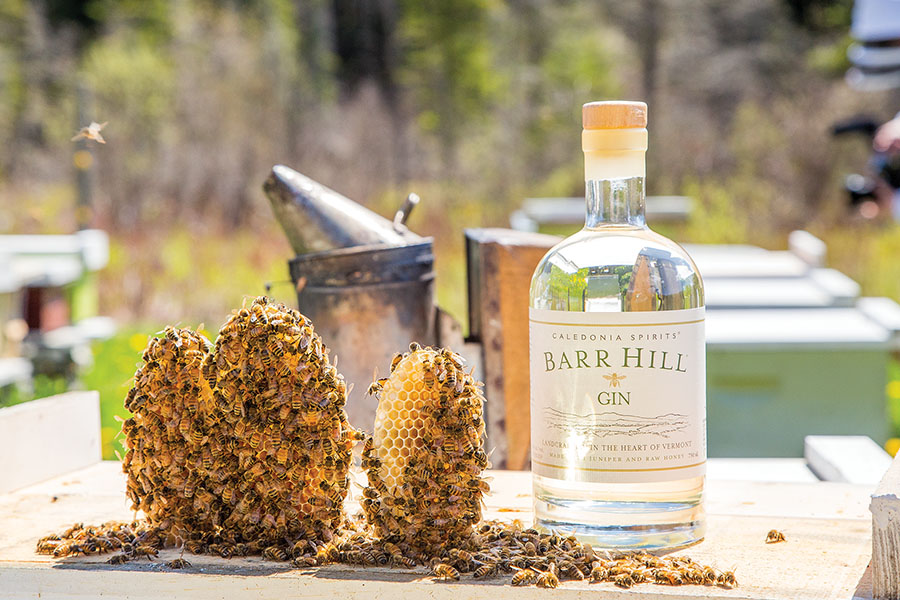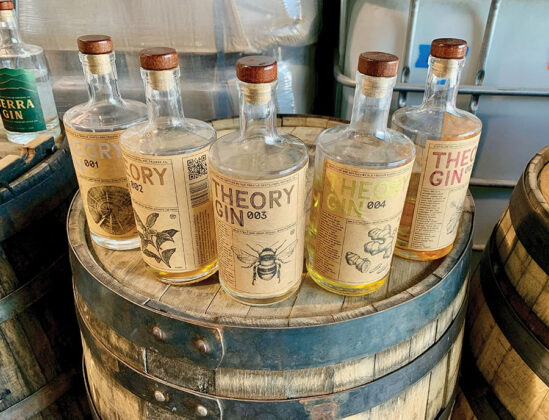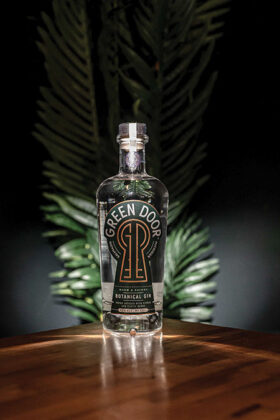Ryan Christiansen throws his tractor in reverse as clouds sail over the countryside of central Vermont. He aims the machine’s steel auger into the grass, drilling holes that his teammates fill with long posts. They’re creating a big wood-and-wire enclosure near a sweeping vista on the mountains. Christiansen, the president of Caledonia Spirits, makers of Barr Hill Gin, plans to harvest a bounty of botanicals across the idyllic forestland he’s looking upon. Except it won’t be him doing the actual foraging — it will be workers with six legs that weigh one-tenth of a gram.
Hundreds of thousands of those micro-foragers, in fact.
Several weeks pass before Christiansen returns to the enclosure to watch as Josh Pitts maneuvers through it in a white beekeeper’s suit. Pitts, assigned to research and development for Barr Hill, is handling six new hives that the team built for local honey. These buzzing boxes are actually on Christiansen’s own land in Washington County; they represent his latest effort to keep Barr Hill Gin communing with Vermont’s floral collectors from the sky.
Inspiration came from the distillery’s co-founder, Todd Hardie, who’s been a beekeeper since he was 12. He and Christiansen built the operation in 2011 near Greenboro’s Barr Hill Natural Area and got to work on gin in a single, direct-fire, 15-gallon pot still. They soon became known for a gin infused with “the beautiful botanical essence of raw honey” from beekeepers across Vermont. Their lauded gin has its honey infused post-distillation rather than during the fermentation process.

In 2019, Barr Hill moved its facility to the Vermont town of Montpelier, along the Winooski River on Gin Lane. At that point, its honey gin became even more local. Christiansen started working with six beekeepers from the surrounding hills in Montpelier, since one alone couldn’t supply the growing demand. He attributes the gin’s popularity partly to the fact that the bees themselves are the droning, natural geniuses behind its botanical approach.
“The bees are out there collecting nectar from hundreds of thousands of different botanical sources,” Christiansen reflects. “They’re collecting it from the flowers and bringing it back to the hive, and then concentrating those flavors — obviously there’s a lot of sugars — but when you keep it raw and unfiltered like in the case with our gin, where we balance out that sweetness with the tiny resin character of juniper, that’s what reveals the field of wildflowers. It’s the ultimate terroir. The bees are out there scraping the earth and its rich botanical flavors.”
That’s why Christiansen has had this battery of beehives constructed on his own land. He wants to continue to learn from his tiny collectors.
“We’re going to boil the flavor of my backyard and hopefully bring that into distilled spirits as well,” he notes.
Now distributed in 34 states, Barr Hill has found enough believers in its botanical technique to launch Bee’s Knees Week, a global cocktail celebration every September that raises money for restoring bee habitat. It’s now one of the largest sustainability drives in the spirits industry, having preserved an estimated half-million square feet of pollinator eco-scapes. Barr Hill is also one of the most unusual examples of a broader and growing trend in American spirits: the commitment to using backyard botanicals in craft gin.
In the state of Washington, the Chehalis Tribe has gotten in touch with its roots by engaging in “backpack foraging” along a convergence of rivers for Talking Cedar Distillery’s gin. In Michigan, the Wolverine State where wolverines no longer roam, there’s a team of gin producers who are roaming the ground as they search the woods for free-growing lavender. The tactic is catching on: From the semiarid steppe of Santa Fe to the most famous lake in the West, distillers are merging their craft with backyard botanicals in ways that lead to interesting new gins.
Gin’s View from Here
Steffany Wolfe crosses an alpine meadow and pauses at the edge of the Truckee River. She watches its current flow by granite boulders and towering sugar pines — a coursing vision that moves down the forest bend and along the lifting bluffs. This serene section of California’s Sierra Nevada mountain range is about 13 miles from the shores of Lake Tahoe. It’s also just a two-minute walk from Old Trestle Distillery, where Wolfe has been focusing on experimental gins since early 2022. Wolfe often strolls over to this river view on her lunch breaks. Sometimes she brings her stubborn Chow Chow, Pfeffernüsse. It’s an inspiring spot for her to meditate on the next steps in Old Trestle’s mission, which includes using time-honored foraging methods around these staggering slopes and peaks in an effort to bottle the true essence of the wild.

Given her background, Wolfe is the ideal distiller to chase that ambition here at the 5,800-foot elevation mark. She was recruited by Old Trestle’s owners, Andy and Alicia Barr, who co-founded FiftyFifty Brewing Co., arguably the best-known craft beer operation in the High Sierra. They’re now supporting Wolfe in distilling spirits that showcase the surrounding mountains, a part of the West that’s been called “the Range of Light.”
In a sense, Wolfe’s entire career had been building in this direction.
After starting as an assistant at a New York State farm distillery, Wolfe went to work for Rising Sun Distillery in Denver, Colorado, where she embraced a commitment to using locally grown fruits and botanicals. From relying on Palisade peaches for brandy, to adding Pueblo chiles to white whiskey, Rising Sun helped Wolfe understand the importance of knowing a region’s agriculture and ecology.
By 2018, Wolfe was working for Santa Fe Spirits in New Mexico, which had a similar philosophy as well as bold foraging strategies to reach its goals. One example that Wolfe always points to is Santa Fe Spirits’ Atapiño Liqueur.
“We’d go off on hikes and pick off, with a knife, the solidified pine sap that comes out, which has a really vanilla, kind of gummy flavor, and the distillery would get that to come apart in high-proof whiskey,” Wolfe remembers. “And then it’s aged with pine nuts in a barrel into a single malt whiskey before adding in the piñon-pine sap. Locals would always say that it tastes like Santa Fe smells during the summer rains.”
Wolfe, who became head distiller at Santa Fe Spirits, also applied this foraging approach to its gin. The team would collect five area botanicals that included white sage, cascade hops, and cholla flowers, which bud on a certain species of cactus. That last part is tricky: The cholla flowers only bloom for two or three days out of the entire year.
“Once it happens, you just have to go,” Wolfe stresses. “We’d bring volunteers. We’d have giant gloves and wrenches and cut off the cholla flowers and collect them all. Once you distill the cholla flower, it has almost a mixture of a honeysuckle rose taste to it. But, for the week after, you’d be pulling cactus pins out of your legs.”
Entranced by the Sierra Nevada mountains, Wolfe eventually found herself running Old Trestle. She works with Michelle Stohlgren, an expert forager who happens to have been one of the original partners in FiftyFifty Brewing Company. Old Trestle contracts with Stohlgren to find an array of high-elevation and alpine meadow botanicals, including bay leaves, yarrow, lemon balm, wild dill, and elderflower. Wolfe, in turn, has used all of those botanicals in Old Trestle’s Theory line of gin. This foraging has to be done with care: California requires a permit for foraging within state forests, while foraging in state parks is generally not allowed. An experienced forager like Stohlgren knows the many areas of the Sierra with no restrictions, as well as the importance of not misidentifying or over-collecting the botanicals being gathered.
At the moment, Wolfe has used the forager’s knowledge to bottle five different Theory gins. While their botanical profiles vary, each gets some degree of character from locally picked Sierra juniper and rosehips. Wolfe distills variations from there, such as Theory 1, which touches the palate with oak inflections, floral touches, and hints of coriander; or Theory 5, which uses a similar formulation but is aged in California zinfandel wine barrels before getting infused with dry hibiscus.
Drunken Monkey, a nearby Truckee sushi restaurant, has been spotlighting the Theory gins in a number of cocktails, particularly ones that use fermented plum juice.
As Old Trestle’s gins have grown in popularity around Lake Tahoe’s tourism scene, Wolfe has started planning to get more resourceful with more Theory products, including ones that remove invasive species from the Sierra Nevada.
“Mediterranean sagebrush is something that is particularly invasive,” Wolfe notes. “It grows all along the highways. So, instead of going out and picking individual leaves of it, what you really want to do is scoop out as much of the actual plant as you can. I think that it just goes along with appreciating how lovely these mountains are.”
Possibilities Behind the Door
Green Door Distilling is all about the history of southwest Michigan: the history of the land and the history of its people.
The Kalamazoo-based operation opened to the public in 2016. “Green door” is an allusion to the emerald paint that was brushed down a building’s entrance if it secretly held a speakeasy. The company also appears to be the first officially legal distillery in Kalamazoo since 1852. But while Green Door’s name may invoke Michigan’s rocky history of regulatory roadblocks, lately its green symbolism applies just as well to its approach for harvesting gin botanicals.

Co-owner Steve Jbara, who’s been with the outfit even before its profile was upped by retired Michigan NBA favorite “Big Ben” Wallace joining the team, says there’s been a kind of guard-your-backyard approach to nearly every product running through his stills. That’s included working with area farmers, cider makers, and coffee roasters. It’s a mentality, if not a credo.
“We wanted products that reflected Michigan and involved everything we could possibly do to get things local,” Jbara says. “That was an easy decision for us.”
When Green Door’s new head distiller Scott Gardner came on last year, he embraced this philosophy and seriously drilled down on what it meant for gin. Gardner has been putting a lot of his energy into wielding the potential of lavender that grows in Kalamazoo.
“Lavender is a pretty local botanical that you don’t really think of when it comes to Michigan,” he remarks. “But we do have a lot of it in the area and it has a fun, savory component that you don’t find in a lot of gins on the market, while still giving some bright lavender notes.”
Gardner elaborates that the true secret sauce to making Green Door’s current gin so exciting includes mixing Kalamazoo’s abundance of lavender with a spice that’s not really native to the place, fenugreek, which has a unique maple syrup-like aroma and flavor.
“It’s also about roasting the fenugreek and some other traditional botanicals to not allow one to shine brighter than the others,” he says. “And that makes for a very balanced drink. We’ve had gin drinkers come try it, and be surprised by how different it is. On the flip side, we’ve had people come in who absolutely despise gin, and after trying it, say, ‘Well, it’s not my go-to, but I like this.’”
Asked if he thinks the backyard botanical approach might generally elevate gin’s reputation as a sipping spirit, Gardner offers some solid optimism.
“Personally, I’ve always loved gin,” he stresses. “Right now, in the world of gin, there is a lot going on and it’s always good to see local distilleries focusing on what really makes their area unique — and doing that through gin.”











